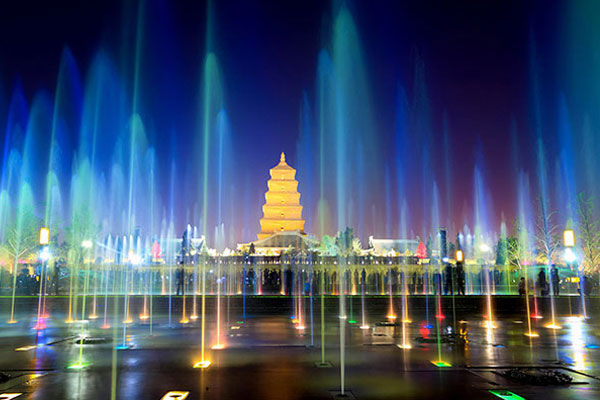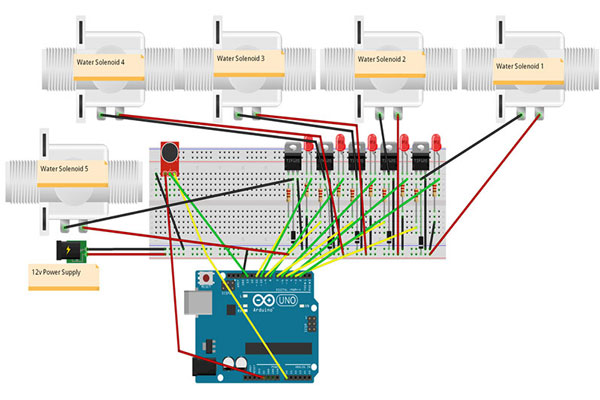23 Nov 2019
The automatic control technology of the musical fountain is the most important technology,the main functions are as follows:
First, advanced music signal processing system
The music signal is analyzed by the spectrum and delayed, and an active component suitable for controlling the fountain in the music signal is extracted and sent to the engineer. Control the machine and delay the music signal to synchronize audio and music.
The second is to concentrate on the distributed control system. The fountain is directly controlled by the main control unit, and the main control machine has the following characteristics:
1. Music signal acquisition function, extracting active components according to frequency characteristics.
2. The fault diagnosis of the source device can diagnose the running status of the host, the leakage and the operating status of the drive cabinet.
3. Menu-based operating system Chinese, which allows the operator to learn to operate in a short period of time, with various dynamic modeling functions and visual mode changes to the music source, allowing the operator to observe changes. Source through the computer screen. The earth promotes the use of music and music sources.
4. Open structure, friendly human-machine interface, communication interface and programming skills are open to users. The music source can be completed with just two mouse buttons to easily match the music source to the library. Gives a refreshing feeling.
5. Direct control of the music fountain directly drives the pump, frequency converter or servo.
6. Steering motor speed and steering control, the maximum control amount is 1024 or more. The controller uses the MUCS source system to interact with any audio source (CD player, recorder, live performance, etc.) to ensure that the music is completely synchronized with the source without affecting the music signal.
Safety and reliability
Each controlled device is equipped with protection against overvoltage, overcurrent and leakage. In the event of a fault, the power supply can be automatically shut off, which reliably protects the road source equipment from loss and personal safety.

The second important technology is water management techniques, it can be summarized into the following categories.
1.Physical and chemical methods
Physical and chemical methods have the advantages of quick effect and easy operation, and are especially suitable for the treatment of small and medium-sized landscape water bodies.
2.Water diversion
When the suspended solids (such as mud and sand) in the water body increase, the transparency of the water body decreases, and the water quality is choppy. The concentration of nutrients and organic matter in the water can be diluted by periodically diverting water and changing water, thereby reducing the concentration of impurities. Prevent algae from growing and improve water quality.
Water aeration and oxygenation is the use of natural water (waterfall, fountain, etc.) or artificial aeration to re-oxygenate the water, promote the mixing of the upper and lower water bodies, maintain the aerobic state of the water body, inhibit the release of nitrogen and phosphorus from the sediment, and prevent the water body. Black stinks. Aeration and oxygenation have high energy consumption and it is difficult to achieve basic nitrogen and phosphorus removal, so it can only be used as an auxiliary treatment.
3.bottom mud
Sediment loose descriptionis an important measure to solve endogenous pollution. It removes nutrients and other pollutants in the sediment through loose of sediment and reduces its release to water. The United States, Japan, Sweden and other countries have conducted descriptionresearch and engineering practice of sediment loose. After two large-scale loose in West Lake, Hangzhou, the main indicators related to eutrophication have improved to varying degrees, zooplankton species increased, phytoplankton biomass and cyanobacteria ratio decreased. The disadvantage of sediment dredging is that the amount of engineering is large, the effect is difficult to last, and the original benthic community may be destroyed. The excavated sludge is likely to cause secondary pollution.
4.In-situ treatment of sediment
The in-situ treatment of sediment includes sedimentation and sediment passivation technology, mainly by covering the sediment with plastic film or granular material, or adding a passivating agent such as aluminum salt and lime to the water body to block and inhibit nitrogen in the sediment. The release of phosphorus nutrients and heavy metals reduces the concentration of nutrients in the water. The Dagow Lake and Globsow Lake in Germany were treated with nitrate and iron complexes. The phosphorus release before treatment was 4-6 mg/(m2•d), and almost no release after treatment. The in-situ treatment technology of the sediment is easy to cause damage to the underwater ecosystem, and it is difficult to ensure the durability of the effect. It is greatly affected by wind and water disturbances, and there are not many engineering applications.

5.Mechanical algae removal
Mechanical algae removal uses algae, algae pumps and other mechanical equipment to catch algae on the surface of the water, indirectly removing nitrogen and phosphorus nutrients from the water. The Institute of Hydrobiology of the Chinese Academy of Sciences mechanically removed the cyanobacteria from Dianchi Lake in 21~2m2 years, and removed 360.83t (dry weight) of cyanobacteria, which is equivalent to removing 37.33t of nitrogen, 2.71t of phosphorus, and organic matter from the water. At 32t, heavy metals in the water are also partially removed. The advantage of mechanical algae removal technology is that it can quickly cope with large-scale outbreaks of algae. It is easy to operate and has no negative effects, but it is only an emergency remedy.
6.Mixing
Advantages such as blending tools available, engineering, operational management, etc., large amount of usable floating material, algal water treatment. Mixing and drinking agent consumption, large production volume of sludge, treatment effect, and long-awaited admission.
7.Over Technology
Excess water technology, water distribution materials, membranes, etc. Over-the-top engineering effects can be achieved quickly, over-the-top, and over-and-the-mill blending agents. Excessive treatment, quality of flooding water, Taya's presence, high level of inhibition, algae, liquid, easy use, etc.
8.Suction technology
Suction technology suitable for water injection in the water body or use raw water flow, super absorbent floor layer, shogi dyed material and soaked material. Sucking and refining processing problems, remediation The technical large-scale application bottles.
9.Algae Technology
Chemicals for microbial algae technology, aqueous algae, regular chemicals, sulfuric acid, liquid, dioxygenated, bleached powder, high-acid, odor, etc. In addition, ultraviolet rays, supersonic waves, microwaves, electrolysis, microelectrolysis, high-magnetism, photo-activated oxygenation, plant lysate, etc. The theory system is still immature, and the long-awaited Kakuya Kagami.杀 Algae technology rapid, direct, but high-performance, short-lasting effect, concomitant algae-like simultaneous toxicity, other aquatic toxicity, general use limited use.
Keywords: musical fountain
Originally published 23 Nov 2019, updated 23 Nov 2019.